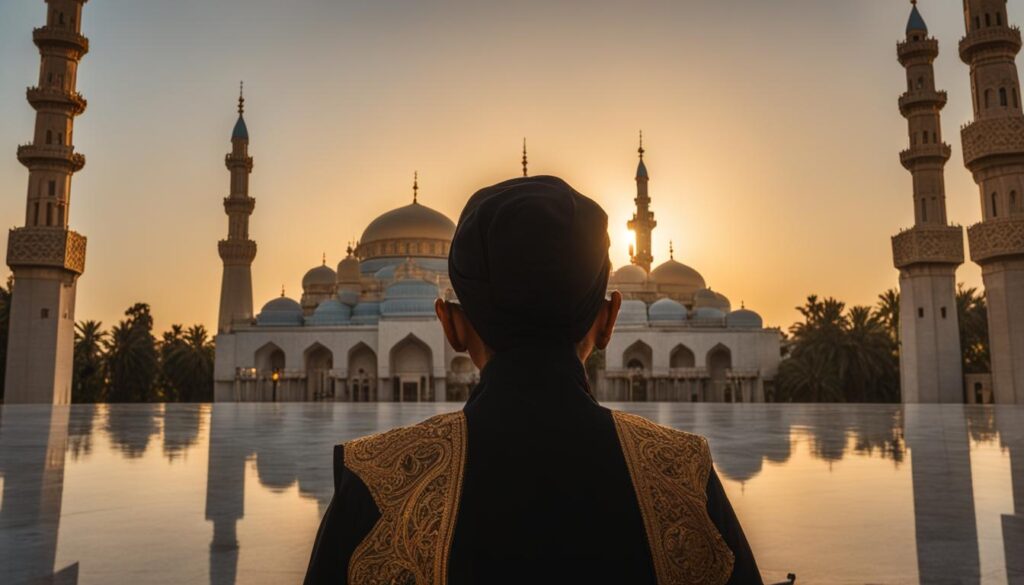The Hanafi prayer method is a specific set of steps and guidelines followed by the followers of the Hanafi school of thought during their prayers. It is crucial to understand and adhere to these nuances to ensure that prayers are performed correctly according to the Hanafi method.
Key Takeaways:
- The Hanafi prayer method involves specific steps and guidelines for performing prayers.
- It is important to raise hands parallel to the earlobes during takbir and place the right hand over the left beneath the navel.
- Reciting specific verses and surahs, performing ruku’ and sujud in a specific manner, and concluding with salaam are integral parts of the Hanafi prayer.
- Practicing the key rituals correctly is essential for a valid Hanafi prayer.
- While there are some differences for men and women, the general structure of prayer remains the same for both.
Understanding the Hanafi Method of Prayer
In the Hanafi school of thought, the method of prayer involves specific steps and guidelines that followers adhere to. It is important to grasp these nuances to perform the prayer correctly. According to the Hanafi prayer technique, there are several key elements that must be followed.
Raising Hands and Reciting Takbir
At the start of the prayer, the Hanafi method requires raising both hands parallel to the earlobes while saying the takbir, which is the declaration “Allahu Akbar” meaning “Allah is the Greatest.”
Placing Right Hand Over Left
Next, the worshipper places the right hand over the left beneath the navel. This hand positioning is an important aspect of the Hanafi prayer steps.
Reciting Verses and Surahs
The recitation of specific verses and surahs is another fundamental aspect of the Hanafi prayer guide. The recitation includes Surah Al-Fatihah, the opening chapter of the Quran, and an additional surah or three verses from any surah.
Bowing, Prostration, and Salaam
The Hanafi prayer method also emphasizes performing ruku’ (bowing) and sujud (prostration) in a specific manner. This involves reciting distinct phrases and supplications during each posture. The prayer concludes with the salaam, a greeting of peace to the right and left.
By following each step accurately and adhering to the guidelines of the Hanafi method, worshippers can perform their prayers in alignment with this school of thought.

The Elements of the Hanafi Prayer Method
The Hanafi method of prayer encompasses various elements that must be followed in order to perform the prayer correctly. Each element holds its own significance and contributes to the overall spiritual experience. Understanding these elements is essential for individuals practicing the Hanafi prayer method.
Instructions and Procedure
- Reciting the Thanāʾ: The prayer begins with the praise of Allah, known as the Thanāʾ. It is a declaration of His greatness and is recited silently.
- Taʿawuzh: This involves seeking refuge in Allah from Satan before reciting the Bismillah.
- Tasmiyyah: Before reciting the first verse of the Quran, Bismillah should be pronounced. This is to seek the blessings of Allah and affirm the intention to pray.
- Recitation of Surah Fatihah and Surah: It is obligatory to recite Surah Fatihah, the opening chapter of the Quran, followed by a Surah or a minimum of three verses from any other Surah. This recitation shows respect and humility towards Allah.
- Rukuʿ and Sujud: During rukuʿ (bowing) and sujud (prostration), specific phrases and supplications should be recited. These actions symbolize submission and reverence towards Allah.
By following these instructions and procedures, individuals can perform the Hanafi prayer method with precision and devotion. Remembering the importance of each element helps create a truly meaningful prayer experience.
Table: Hanafi Prayer Elements
| Element | Description |
|---|---|
| Reciting the Thanāʾ | The prayer begins with the praise of Allah. |
| Taʿawuzh | Seeking refuge in Allah from Satan before reciting the Bismillah. |
| Tasmiyyah | Reciting Bismillah, seeking the blessings of Allah and affirming the intention to pray. |
| Recitation of Surah Fatihah and Surah | Reciting Surah Fatihah and a Surah or three verses from any other Surah. |
| Rukuʿ and Sujud | Performing specific phrases and supplications during bowing and prostration. |
It must be noted that practicing the Hanafi prayer method requires adherence to the rules and guidelines set forth by the Hanafi school of thought. This ensures the prayer is performed in accordance with the teachings and traditions of the Hanafi methodology.
Performing the Hanafi prayer method not only involves the physical actions of prayer but also requires a deep sense of spirituality and devotion. The elements of this method serve as a means to connect with Allah and attain a state of tranquility and mindfulness during prayer.
By familiarizing oneself with the elements and their significance, individuals can perform the Hanafi prayer method with mindfulness and reverence, reaping the spiritual benefits of this ancient tradition.
Key Rituals in the Hanafi Prayer Method
As part of the Hanafi prayer method, there are several key rituals that should be observed. These rituals help create a meaningful and spiritually fulfilling prayer experience. Here are some of the important rituals:
Takbir
The prayer begins with takbir, where the worshipper raises their hands to their ears and says “Allahu Akbar,” meaning “Allah is the Greatest.” This gesture marks the start of the prayer and serves as a reminder of the worshipper’s submission to Allah.
Ruku’
During ruku’, the worshipper bends from the waist, placing their hands on their knees. While in this position, they recite the phrase “Subhan Allah,” which means “Glory be to Allah.” This act of bowing symbolizes humility and the recognition of Allah’s greatness.
Sujud
In sujud, the worshipper prostrates themselves with their forehead, nose, hands, knees, and toes touching the ground. While in this position, they recite “Subhan Allah,” again affirming the glory of Allah. This act of prostration represents the deepest level of submission and surrender to Allah’s will.
Tashahud
The prayer concludes with tashahud, where the worshipper sits and recites a specific supplication, including blessings upon the Prophet Muhammad (peace be upon him). This serves as a moment of reflection and gratitude before concluding the prayer with salaam.
| Ritual | Description |
|---|---|
| Takbir | Worshipper raises hands to ears and says “Allahu Akbar” to begin the prayer. |
| Ruku’ | Worshipper bends from the waist, placing hands on knees, and recites “Subhan Allah” to symbolize humility. |
| Sujud | Worshipper prostrates themselves, touching the ground with their forehead, nose, hands, knees, and toes, while reciting “Subhan Allah.” |
| Tashahud | Worshipper sits and recites a supplication, including blessings upon Prophet Muhammad (pbuh), before concluding the prayer with salaam. |
By adhering to these key rituals in the Hanafi prayer method, followers can enhance their spiritual connection with Allah and experience the profound benefits of prayer.

Differences in the Hanafi Prayer for Men and Women
While the general structure and steps of prayer are the same for both men and women in the Hanafi prayer method, there are some notable differences. These differences are based on the teachings and interpretations of the Hanafi school of thought, which take into account the physical and physiological differences between men and women.
One key difference is in the way women raise their hands during the takbir (saying “Allahu Akbar” to commence prayer). While men raise their hands parallel to their ears, women are advised to raise their hands to their shoulders. This is to maintain modesty and is considered a recommended practice for women in the Hanafi prayer method.
Another difference is in the postures during ruku’ (bowing) and sujud (prostration). Men are instructed to spread their fingers and keep them apart, while women are advised to keep their fingers close together and hold them in a relaxed manner. Women also place their forearms on the ground during sujud, while men rest their elbows on the ground.
It is important for women to familiarize themselves with these differences and adapt their prayer accordingly. By following the guidelines of the Hanafi school of thought, women can perform their prayers in a manner that aligns with their beliefs and traditions.
| Men | Women |
|---|---|
| Raise hands parallel to ears during takbir | Raise hands to shoulders during takbir |
| Spread fingers apart during ruku’ and sujud | Keep fingers close together during ruku’ and sujud |
| Rest elbows on the ground during sujud | Place forearms on the ground during sujud |
Additional Considerations in the Hanafi Prayer Method
Aside from the basic steps and rituals, there are additional guidelines and nuances that followers of the Hanafi prayer method should be aware of. These considerations help ensure that the prayers are performed correctly and in accordance with the Hanafi school of thought.
Supplications during Prayer
One important aspect of the Hanafi prayer method is the inclusion of specific supplications during the prayer. These supplications are recited at various points throughout the prayer and serve as a means of seeking blessings, mercy, and forgiveness from Allah. They can be personal or taken from the teachings of the Prophet Muhammad (peace be upon him). Examples of these supplications include seeking guidance, expressing gratitude, and asking for protection from evil. By incorporating these supplications into their prayers, followers of the Hanafi method can deepen their spiritual connection with Allah.
Recitation of Tashahud and Salat Was Salaam
In addition to the Quranic recitations, the Hanafi prayer method includes the recitation of specific prayers, known as the Tashahud and Salat Was Salaam. The Tashahud is recited while sitting in the final tashahud position of the prayer. It is a testimony of faith and a declaration of belief in the oneness of Allah and the prophethood of Muhammad (peace be upon him). Salat Was Salaam refers to the sending of blessings and peace upon the Prophet Muhammad (peace be upon him). These additional recitations hold great significance in the Hanafi prayer method and should be recited with reverence and sincerity.
Performing More than Two Rak’ahs
In certain circumstances, such as during voluntary prayers or specific prayer times, it may be necessary to perform more than the usual two rak’ahs. The Hanafi prayer method provides guidelines on how to perform these additional rak’ahs with the appropriate recitations and movements. It is important to follow these guidelines to ensure that the prayer remains valid and in accordance with the Hanafi method.
| Additional Considerations | Description |
|---|---|
| Supplications during Prayer | Include specific supplications to seek blessings, mercy, and forgiveness from Allah. |
| Recitation of Tashahud and Salat Was Salaam | Recite the Tashahud and send blessings and peace upon the Prophet Muhammad (peace be upon him). |
| Performing More than Two Rak’ahs | Follow guidelines to perform additional rak’ahs in voluntary or specific prayer times. |
Importance of Focused Gaze in the Hanafi Prayer Method
One of the key aspects of the Hanafi prayer method is maintaining a focused gaze during the prayer. Followers are advised to keep their eyes fixed on the place of prayer and avoid distractions or wandering gazes. This practice helps enhance concentration and mindfulness during prayer.
According to the Hanafi school of thought, maintaining a focused gaze is essential for achieving a deeper connection with Allah. By directing their eyes towards the place of prayer, believers can anchor their attention and prevent their minds from wandering. This level of focus allows individuals to fully immerse themselves in the spiritual experience of prayer, increasing their mindfulness and creating a stronger connection with the divine.
The focused gaze serves as a powerful tool for concentration in the Hanafi prayer method. It helps to block out external distractions and internal thoughts, enabling believers to enter a state of tranquility and devoted worship. By maintaining a fixed gaze, individuals can bring their entire being into the present moment, cultivating a heightened awareness of their surroundings and their relationship with Allah.
Ultimately, the focused gaze in the Hanafi prayer method is not simply a physical act, but a means to attaining spiritual elevation. It creates an environment of undistracted devotion, allowing individuals to fully engage in their prayers and experience the profound benefits of connecting with Allah. By incorporating this practice into their prayer routine, followers of the Hanafi school of thought can deepen their spiritual journey and strengthen their bond with the divine.
Recommended Mannerisms in the Hanafi Prayer Method
The Hanafi prayer method not only provides specific steps and guidelines for performing prayers but also emphasizes the importance of mannerisms and etiquettes during the prayer. These recommended mannerisms help in enhancing the spiritual experience and deepening the connection with Allah. Let’s explore some of the key mannerisms and etiquettes recommended in the Hanafi prayer method.
1. Clear Intention:
Before starting the prayer, it is important to have a clear and sincere intention. The intention should be solely for the sake of Allah, seeking His pleasure, and not for any worldly gain or recognition. By purifying the intention, the prayer becomes an act of worship and devotion that brings spiritual benefits.
2. Calm and Collected Demeanor:
Throughout the prayer, it is essential to maintain a calm and collected demeanor. Avoid rushing through the prayer and perform each action with tranquility and focus. This helps in developing mindfulness and concentration, allowing for a deeper spiritual experience.
3. Raising Hands with Palms Facing the Qiblah:
When raising the hands for takbir (saying “Allahu Akbar”) at the beginning of the prayer and during other specific actions, it is recommended to raise the hands with the palms facing towards the qiblah (the direction of the Kaaba in Makkah). This signifies humility and submission to Allah’s greatness.
By practicing these recommended mannerisms and etiquettes in the Hanafi prayer method, individuals can enhance their connection with Allah and experience the true essence of prayer. It is important to remember that these mannerisms are meant to bring sincerity, focus, and humility to the worshipper, allowing for a more profound spiritual experience.
Conclusion
The Hanafi prayer method offers a comprehensive and structured approach to worship, providing specific steps, rituals, and guidelines for followers. By understanding and practicing this method correctly, individuals can deepen their connection with Allah and experience the spiritual benefits of prayer.
It is essential to follow the guidance of scholars and adhere to the teachings of the Hanafi school of thought to perform prayers in the Hanafi method accurately. This ensures that each step and ritual is performed in the prescribed manner, allowing for a meaningful and fulfilling prayer experience.
Through the Hanafi prayer method, individuals can cultivate mindfulness, focus, and a sense of calm during their prayers. By following the recommended mannerisms and maintaining a focused gaze, worshippers can enhance their concentration and spiritual experience.
Ultimately, the Hanafi prayer method serves as a means to establish a deep connection with Allah and seek His blessings. By practicing this method with sincerity and dedication, individuals can enrich their prayer journey and find solace in their worship.
FAQ
What is the Hanafi prayer method?
The Hanafi prayer method refers to the specific steps and guidelines followed by followers of the Hanafi school of thought during their prayers.
What are the key rituals in the Hanafi prayer method?
Some key rituals in the Hanafi prayer method include raising hands for takbir, placing hands on the knees during ruku’, and reciting specific phrases in ruku’ and sujud.
Are there differences in the Hanafi prayer for men and women?
Yes, there are slight differences in the Hanafi prayer method for men and women, such as the way hands are raised during takbir and modified postures during ruku’ and sujud for women.
What additional considerations are there in the Hanafi prayer method?
The Hanafi prayer method includes guidelines for performing more than two rak’ahs, recitation of tashahud and salat was salaam, and supplications during prayer.
Why is maintaining a focused gaze important in the Hanafi prayer method?
Maintaining a focused gaze helps enhance concentration and mindfulness during prayer, allowing for a deeper spiritual experience.
What are some recommended mannerisms in the Hanafi prayer method?
Recommended mannerisms in the Hanafi prayer method include starting with a clear intention, raising hands with palms facing the qiblah, and maintaining a calm demeanor throughout the prayer.








